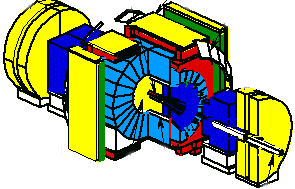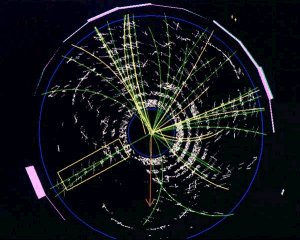Inquiring Minds
|
The science of matter, space and time main page | what is the world made of? | how to find the smallest particles what to expect in the future | why support science | Standard Model discoveries |
||||||
|
||||||
|
Matter at the smallest scale is made of elementary particles, pieces of matter that cannot be divided into anything smaller. As scientists over the past century have looked deeper and deeper into the atom, they have found the smallest things human beings have ever seen. How do they do it? The first step: accelerators The collision of particles at high energy allows physicists not only to look at what's inside these particles, but to use the energy of their collisions to create different, more massive and more exotic particles of matter. To create such high-energy collisions, scientists must use very powerful particle accelerators, such as Fermilab's Tevatron.
When people think of high-energy particle collisions, they often imagine explosive power. Yet, at the Tevatron, one of the world's most powerful accelerators, the collision of two particles releases an amount of energy that is comparable to the energy needed by a mosquito to fly. Because they are concentrated in such a small space, they have the power to crack protons and occasionally to produce a pair of top quarks, which have about the mass of gold atoms. The illustration shows how such an event proceeds and how the short-lived top quarks decay into lighter particles. The second step: detectors Unveiling the tiniest constituents of matter with accelerators is only half the battle. Physicists also need extraordinary particle detectors to observe what happens in high-energy collisions. Detectors are instruments that count particles, visualize tracks, measure particle energies, record time-of-flight and identify different particles. Detectors can be as tiny as computer chips or as big as apartment houses, containing thousands of tons of steel and other material.
One of the most important tasks of the detector electronics, called triggering, is the selection of collision signals that are interesting enough to be recorded permanently for later examination. It is unnecessary and impossible to keep the ten thousands of detector signals created every millionth of a second. Physicists build and program the detector hardware to perform several levels of go or no-go decisions before passing the data to the next, more sophisticated level of processing. At Fermilab's CDF and DZero detectors, fewer than a thousand events per second pass the highest trigger level for permanent storage, still producing almost 100 megabytes of data written to tape per second. Future experiments will need even faster electronics. The third step: data analysis Detectors are the product of international collaborations of physicists, all contributing their own expertise and the support of their home institutions. In return, each physicist receives access to the data recorded. To simplify the networking and data-exchange within these worldwide collaborations, scientists at the European research laboratory CERN invented the World Wide Web. High-energy laboratories such as DESY, SLAC and Fermilab were among the first to offer web pages in their home countries.
|
| last modified 3/25/2004 email Fermilab |
FRLsDFx9eyfrPXgV





